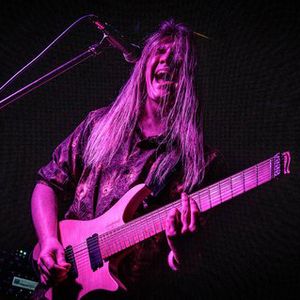"I really wanted to say, ‘See, there’s nobody out there, so we gotta walk away from this.’ But I couldn’t." Scott Gorham on how John Sykes' heavy metal thunder gave Thin Lizzy one last chance
Gorham played with some serious guitar talents in Thin Lizzy, but Sykes brought a “fiery” edge like no other

Between 1974 and 1983, Scott Gorham joined forces with a revolving door of guitar greats at the heart of Thin Lizzy’s harmony-laden sound. From Brian Robertson’s melodicism to Gary Moore’s flair and Snowy White’s blues leanings, Gorham constantly reinvented himself to fit with his co-guitarist.
Yet no guitarist left him sweating quite like John Sykes.
When White departed the band after 1981’s Renegade, Gorham and Phil Lynott had different thoughts about where to go next. Speaking to Guitarist, Gorham says he knew the band’s drug usage was bruising their legacy, and Lynott thought he knew just the tonic. Both agreed that, whatever happened, Thin Lizzy’s days were numbered.
“I told Phil we had to stop this whole thing. The drug addictions. Phil losing his voice. The mistakes we were now making onstage,” he explains. “So I said, ‘Let's wrap this thing up. Let's get our shit together and when we both get healthy, we'll hit everybody over the head with a fucking sledgehammer.’”
The band, however, would need their sledgehammer. Gorham says he flirted with the idea of moving forward without a guitar partner after Dutch virtuoso Adrian Vandenberg turned them down.
“There was a lot of heavy drug use around that band,” Vandenberg told Classic Rock in 2023, “and I never wanted to be part of that scene.”
Lynott then set his eyes on John Sykes. He had impressed during an adrenaline-filled stint in Tygers of Pan Tang, which saw him release two albums full of blazing guitar solos in 1981.
All the latest guitar news, interviews, lessons, reviews, deals and more, direct to your inbox!
“Phil says, ‘I promise you, you're gonna like him,’” Gorham relays. His arm was twisted.
“So John Sykes comes down, and I couldn’t fault him in any way. I really wanted to say, ‘See, there’s nobody out there, so we gotta walk away from this.’ But I couldn’t. He was a great player. He was a one-guitar guy. Never, ever did I see him play anything but his black Les Paul. And he looked great onstage, too. So what was not to like?”
As Gorham confesses, Sykes’ talents were undeniable. A few years later, when he joined a floundering Whitesnake, Sykes showed his ability to light the fuses of sleeping rock and roll giants. When he left the group, Steve Vai was left to fill his void, and he knew he could never match the “indelible” mark he left on the British band.
The problem was that Sykes wasn’t another player cut, like Moore, White, and Eric Bell before them, from a blues-rock mould. Heavy metal coursed through his veins, and the young guitarist had a point to prove on Thin Lizzy’s tumultuous final album, Thunder and Lightning.
“We were not a metal band," Gorham states. "But John brought in that metal edge. He had a fiery style, and I stepped up my sound to match his.
“Really, his strength was the quickness. He wasn’t about subtleties. Every track he wanted faster. He’d turn around to [drummer] Brian Downey and say, ‘Hey man, can you kick it up a couple?’ And I’d have to say, ‘John, it’s getting out of control.’ He wanted to show everybody how fast he was.”
The material for Thunder and Lightning was locked in place before Sykes arrived, save for its lead single, “Cold Sweat,” which Sykes co-wrote. Gorham points to that track as the “best” song the Sykes era produced.

“But there was no middle ground with ‘Thunder and Lightning,’” he adds, over 40 years on. “Lizzy fans loved it or hated it.”
He’d turn around to Brian Downey and say, ‘Hey man, can you kick it up a couple?’ And I’d have to say, ‘John, it’s getting out of control.’
Scott Gorham
As promised internally, Thin Lizzy bowed out after touring the album. Their final show together was at the Monsters of Rock festival in Nuremberg, Germany on September 4. Though the band members went their separate ways, Lynott hung onto Sykes as he went on to form Grand Slam, knowing his dynamism would be one of their strongest weapons.
The band, however, never took off, and Phil Lynott’s drug dependence ultimately killed him in 1986. Ten years later, Sykes persuaded Scott Gorham, Brian Downey and Darren Wharton to return to reform Thin Lizzy, ostensibly billing the band as a tribute to Lynott, which Sykes fronted.
Sykes passed away after a long battle with cancer in January. But as Vai says, the mark he left on every band he played in was indelible.
Scott Gorham has recently revealed that he briefly died on the operating table as he battled a serious health condition. Like Robert Fripp, who suffered a heart attack earlier this year, he is expected to make a full recovery.
A freelance writer with a penchant for music that gets weird, Phil is a regular contributor to Prog, Guitar World, and Total Guitar magazines and is especially keen on shining a light on unknown artists. Outside of the journalism realm, you can find him writing angular riffs in progressive metal band, Prognosis, in which he slings an 8-string Strandberg Boden Original, churning that low string through a variety of tunings. He's also a published author and is currently penning his debut novel which chucks fantasy, mythology and humanity into a great big melting pot.


